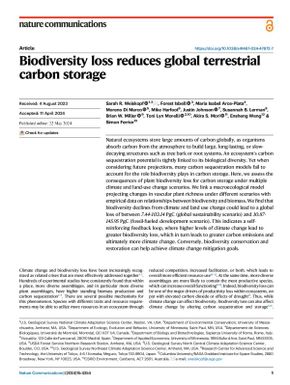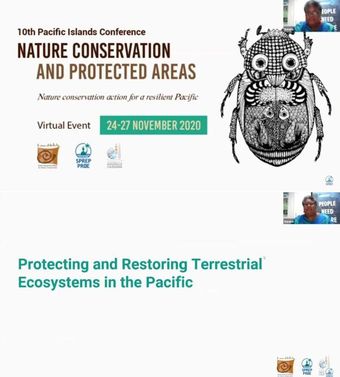Biodiversity loss reduces global terrestrial carbon storage
- Description:
- Addressing climate change and biodiversity loss together will more effectively address these crises. Although policymakers are starting to think about climate change mitigation initiatives that have co-benefits for biodiversity, the role of biodiversity itself in promoting carbon storage is often overlooked, with much focus simply on biomass or ecosystem extent. On one hand, this may mean that the scientific community is underestimating future carbon emissions by not accounting for biodiversity-driven carbon losses, thus increasing the urgency for mitigating climate and land-use impacts. On the other hand, this highlights the important role that ecosystem restoration, focusing on the composition of these ecosystems, can play in climate change mitigation. In other words, there is potential to link the restoration target (T2) of the Convention on Biological Diversity (CBD) Kunming-Montreal Global Biodiversity Framework with that for climate-change mitigation (T8) and enhancing nature’s contributions to people (T11), emphasizing a need to reconsider the functional value of biodiversity rather than focusing only on area-based measures for conservation (e.g., so-called 30 by 30; T3)62. At a national and local level, this could mean that a focus on maintaining and restoring diverse ecosystems can increase the return-on-investment for carbon storage over the same land area. This may be particularly important for those ecoregions that are projected to have high levels of biodiversity-driven carbon loss.
- Display date:
- 2024
- Location:
- Worldwide
- Collections:
- Secretariat of the Pacific Regional Environment Programme (SPREP)
- Publisher:
- Springer Science and Business Media LLC
- Content partner:
- Secretariat of the Pacific Regional Environment Programme (SPREP)
- Availability:
- Not specified
-
Copyright status: All rights reservedFind out more about what you are able to do with this itemThis item is all rights reserved, with means you'll have to get permission from Secretariat of the Pacific Regional Environment Programme (SPREP) before using it. For more information, please see our use and reuse page.What can I do with this item?Non-infringing useNZ copyright law does not prevent every use of a copyright work, and this item may be hosted by an international institute or organisation. You should consider what you can and cannot do with a copyright work.No sharingYou may not copy and/or share this item with others without further permission. This includes posting it on your blog, using it in a presentation, or any other public use.No modifyingYou are not allowed to adapt or remix this item into any other works.No commercial useYou may not use this item commercially.
Related items
Welcome and warm Pasifik greetings
The information on this site has been gathered from our content partners.
The names, terms, and labels that we present on the site may contain images or voices of deceased persons and may also reflect the bias, norms, and perspective of the period of time in which they were created. We accept that these may not be appropriate today.
If you have any concerns or questions about an item, please contact us.

